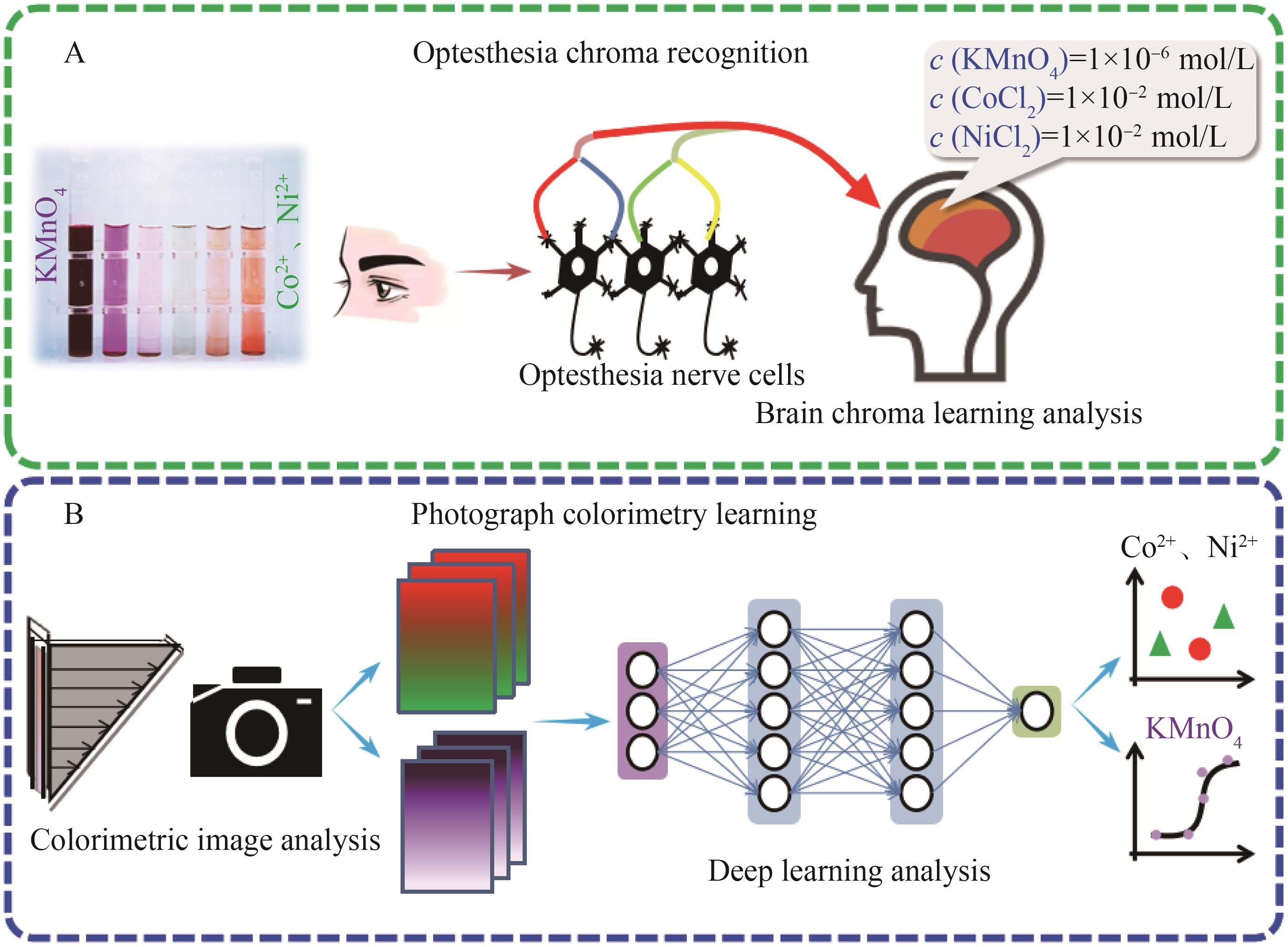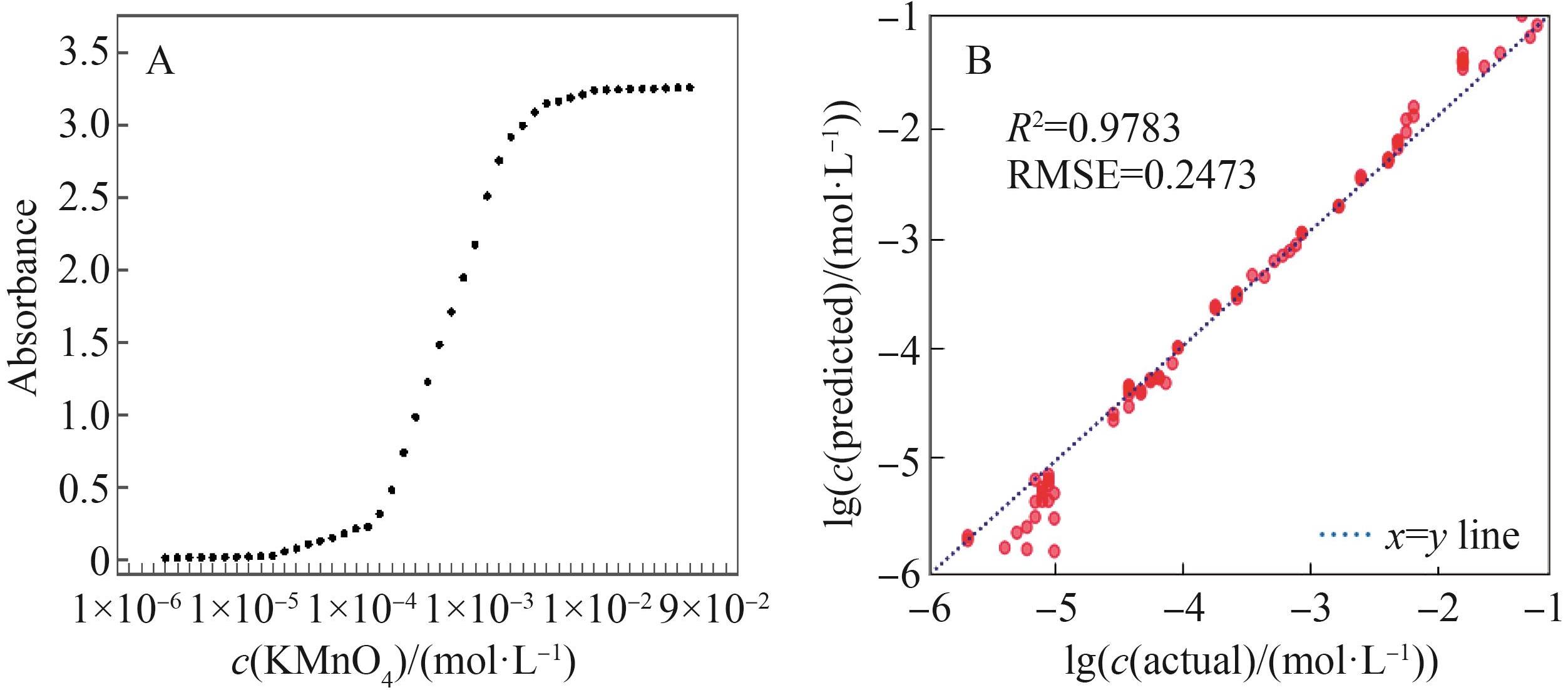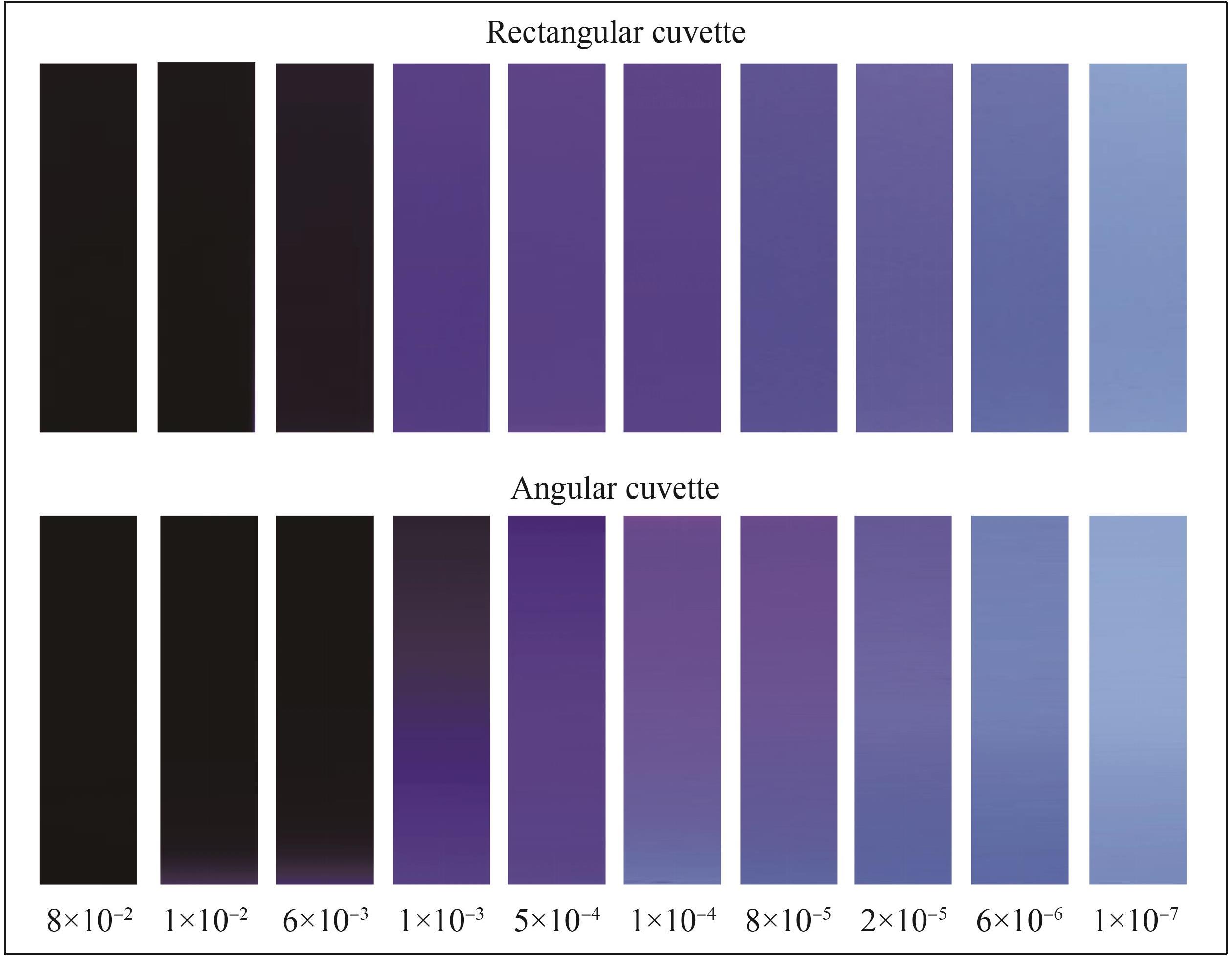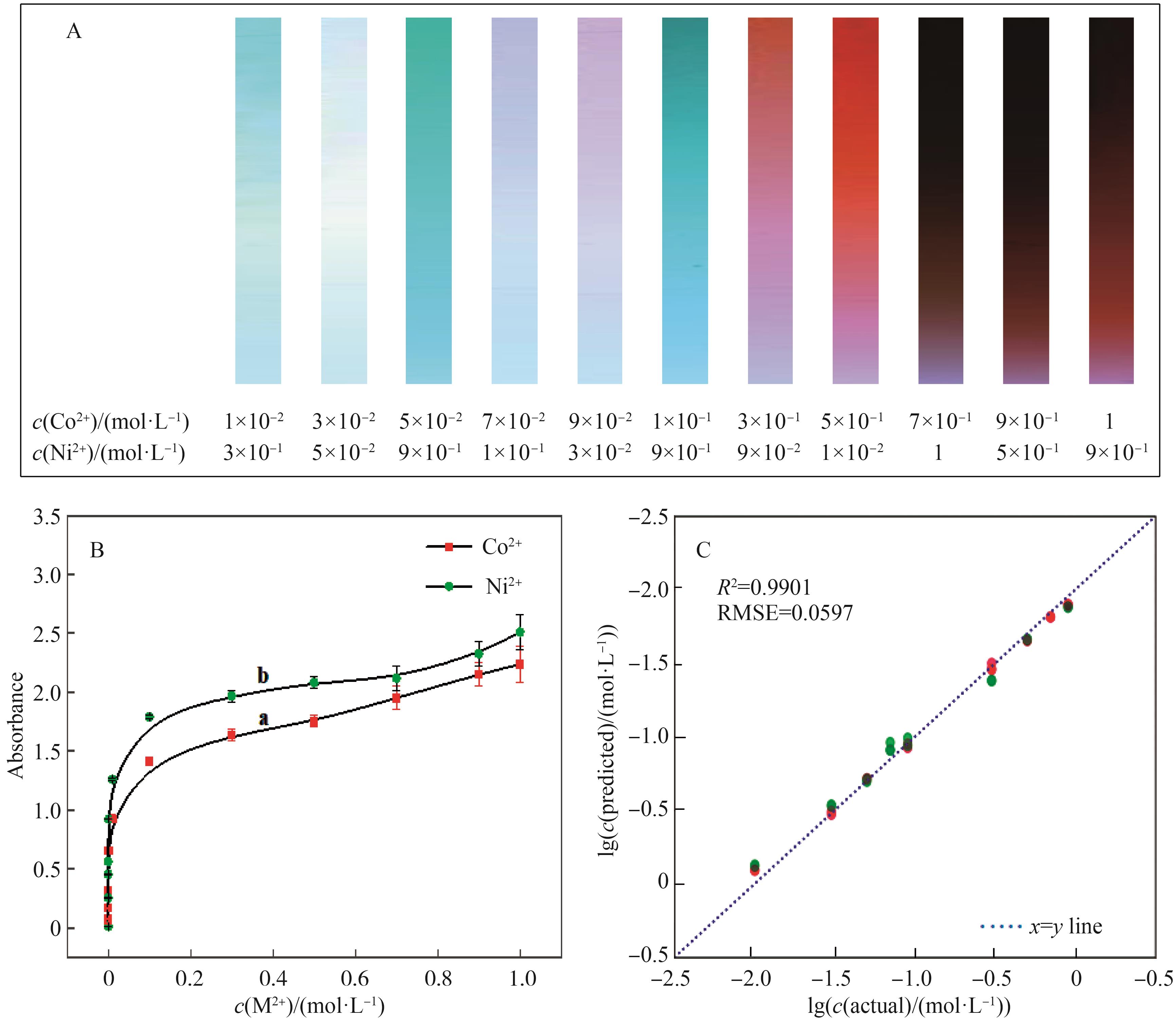
Chinese Journal of Applied Chemistry ›› 2022, Vol. 39 ›› Issue (1): 196-204.DOI: 10.19894/j.issn.1000-0518.210459
• Full Papers • Previous Articles
Optesthesia Inspired Chroma Analysis for Rapid Chromatic Concentration Determination
LIU Zhi-Hao,TAN Xiao-Qing,LIANG Yong-Peng,XIA Chao,MENG Jian-Xin( ),LI Feng-Yu(
),LI Feng-Yu( )
)
- College of Chemistry and Materials Science,Guangdong Provincial Key Laboratory of Functional Supramolecular Coordination Materials and Applications,Jinan University,Guangzhou 510632,China
-
Received:2021-09-09Accepted:2021-11-11Published:2022-01-01Online:2022-01-10 -
Contact:Jian-Xin MENG,Feng-Yu LI -
About author:llifengyu@jnu.edu.cn; tmjx@jnu.edu.cn
-
Supported by:the National Natural Science Foundation of China(21874056);the National Key Research and Development Program(2016YFC1100502);Guangdong Provincial Key Laboratory of Functional Supramolecular Coordination Materials and Applications
CLC Number:
Cite this article
LIU Zhi-Hao, TAN Xiao-Qing, LIANG Yong-Peng, XIA Chao, MENG Jian-Xin, LI Feng-Yu. Optesthesia Inspired Chroma Analysis for Rapid Chromatic Concentration Determination[J]. Chinese Journal of Applied Chemistry, 2022, 39(1): 196-204.
share this article

Fig.1 Bionic photographing colorimetric learning based on optesthesia inspired chroma analysis(A) Optesthesia chroma recognition (human eyes observe samples of different concentrations, which are transmitted to the cerebral cortex through optesthesia nerve cells to form optesthesia perception, so as to realize semi-quantitative analysis of samples);(B) Photographing colorimetric learning (camera captures and collects a large number of pictures, inputs them into convolutional neural network to learn human optesthesia system, and realizes quantitative analysis of samples based on chromaticity and brightness of samples)

Fig.2 Comparison of detection concentration range of KMnO4 by spectrophotometry and photographic colorimetry(A) Concentration dependence of 1×10-6~9×10-2 mol/L KMnO4 detection with UV-Vis spectrophotometry analysis;(B) Concentration dependence of 1×10-6~9×10-2 mol/L KMnO4 detection with photographic colorimetric analysis

Fig.3 Photograph table of rectangular cuvette (above) and angle cuvette (below) images for various KMnO4 solutions at 1×10-7~8×10-2 mol/L (unit: mol/L)

Fig.4 Actual vs predicted concentration for the test set of KMnO4 detection at 1×10-6 ~ 8×10-2 mol/L(A) Rectangular cuvette performed 97.83% accuracy; (B) Angle cuvette achieved 99.88% accuracy

Fig.5 Concentration dependence of Co2+ and Ni2+ mixed solutions via colorimetric photography or spectrophotometry(A) The angle cuvette to photographic colorimetric diagram of 1×10-2~1 mol/L Co2+, Ni2+ mixed solution; (B) The UV?Vis spectra analysis map of 1×10-2~1 mol/L Co2+ (a), Ni2+ (b) mixed solution; the absorption of Co2+ (a) at 513 nm, or Ni2+ (b) at?395 nm was monitored; (C) The photographic colorimetric map of 1×10-2~1 mol/L Co2+ (red spot), Ni2+ (green spot) mixed solution. The 99.01% accuracy was achieved
| 1 | ROBERT C H. Ultraviolet Spectrophotometry[J]. Anal Chem, 1958, 30(4): 589-593. |
| 2 | YUAN W H, ZHAO L, YANG J Z, et al. Insights into the decomposition and oxidation chemistry of p-xylene in laminar premixed flames[J]. J Phys Chem A, 2021, 125(15): 3189-3197. |
| 3 | EHNERT S, SEEHASE J, WULLER-RENNO C, et al. Simultaneous quantification of total carbohydrate and protein amounts from aqueous solutions by the sulfuric acid ultraviolet absorption method (SA-UV method)[J]. Anal Chim Acta, 2021, 5(3): 1174-1184. |
| 4 | LIU Z X, TIAN W G, JI X, et al. Visualized discriminant analysis and recognition of multiple metal ions with a single cellulose-based fluorescent probe[J]. ACS Sustainable Chem Eng, 2021, 9(28): 9376-9385. |
| 5 | SUN L, ROTARU A, ROBEYNS K, et al. A colorimetric sensor for the highly selective, ultra-sensitive, and rapid detection of volatile organic compounds and hazardous gases[J]. Ind Eng Chem Res, 2021, 60(24): 8788-8798. |
| 6 | TU E, PEARLMUTTER P, TIANGCO M, et al. Comparison of colorimetric analyses to determine cortisol in human sweat[J]. ACS Omega, 2020, 5(14): 8211-8218. |
| 7 | HIROSHI M, SU P, DOOUBERLY G E. Fabrication of nanocrystal tube using peptide tubule as template and its application as signal-enhancing cuvette[J]. Phys Chem, 2001, 105(9): 1683-1686. |
| 8 | WHITEHEAD H D, WALDMAN J V, WIRTH D M, et al. 3D printed UV-Visible cuvette adapter for low-cost and versatile spectroscopic experiments[J]. ACS Omega, 2017, 2(9): 6118-6122. |
| 9 | DARIN Z, BIRTHE DM, MAJED F, et al. Developing a simple method to enhance the generation of cone and rod photoreceptors in pluripotent stem cell-derive retinal organoids[J]. Stem Cells, 2020, 38(1): 45-51. |
| 10 | NICK S, GENMANY FRANZ F. Visual shape perception in the case of transparent objects[J]. JOV, 2019, 19(24): 1-36. |
| 11 | JOSEPH B, ALISTAIR B, ROBERT P, et al. The perceived size and shape of objects in peripheral vision[J]. i-Perception, 2016, 8(17): 1-23. |
| 12 | CAMILLE C, THOMAS E, TIMM S. How do horizontal cells ‘talk’ to cone photoreceptors? different levels of complexity at the cone-horizontal cell synapse[J]. J Physiol, 2017, 595(16): 5495-5506. |
| 13 | HOLZNER G, KRIEL F H, PRIEST C. Pillar cuvettes: capillary-filled, microliter quartz cuvettes with microscale path lengths for optical spectroscopy[J]. Anal Chem, 2015, 87(9): 4757-4764. |
| 14 | SONG H M, SOKOLOV M. Analysis of protein expression and compartmentalization in retinal neurons using serial tangential sectioning of the retina[J]. J Proteome Res, 2009, 8(28): 346-351. |
| 15 | ERIKSEN A Z, ELIASEN R, OSWALD R, et al. Multifarious biologic loaded liposomes that stimulate the mammalian target of rapamycin signaling pathway show retina neuroprotection after retina damage[J]. ACS Nano, 2018, 12(8): 7497-7508. |
| 16 | LUCHOWSKI R, GRUDZINSKI W, WELC R, et al. Light-modulated sunscreen mechanism in the retina of the human eye[J]. J Phys Chem B, 2021, 125(23): 6090-6102. |
| 17 | LIU Y X, LIU M, ZHANG X C, et al. Protective effect of fucoxanthin isolated from laminaria japonica against visible light-induced retinal damage both in vitro and in vivo[J]. J Agric Food Chem, 2016, 64(2): 416-424. |
| 18 | DUAN Q N, LEE J C, ZHENG S R, et al. A color-spectral machine learning path for analysis of five mixed amino acids[J]. Chem Commun, 2020, 56(31): 1058-1061. |
| 19 | XING J, ZHENG S X, DIND D, et al. Deep learning for prediction of the air quality response to emission changes[J]. Environ Sci Technol, 2020, 54(20): 8589-8600. |
| 20 | JU L, LYU A H, HAO H X, et al. Deep learning-assisted three-dimensional fluorescence difference spectroscopy for identification and semi-quantification of illicit drugs in biofluids[J]. Anal Chem, 2019, 91(15): 9343-9347. |
| 21 | GUO L L, WANG T, WU Z H, et al. Portable food-freshness prediction platform based on colorimetric barcode combinatorics and deep convolutional neural networks[J]. Adv Mater, 2020, 32(45): 2004805. |
| 22 | ZHENG L, ASKIM J R, SUSLICK K S. The optoelectronic nose: colorimetric and fluorometric sensor arrays[J]. Chem Rev, 2019, 119(1): 231-292. |
| 23 | CAROLOS H, RIOS M, CHRISTOPHE D. Rapid determination of ionization constants (pKa) by UV-spectroscopy using 96-well microtiter plates[J]. ACS Med Chem Lett, 2013, 4(1): 142-145. |
| 24 | HAN J K, GEUM D M, LEE M W, et al. Bioinspired photo responsive single transistor neuron for a neuromorphic visual system[J]. Nano Lett, 2020, 20(12): 8781-8788. |
| 25 | CHO S Y, LEE Y H, LEE S W, et al. Finding hidden signals in chemical sensors using deep learning[J]. Anal Chem, 2020, 92(9): 6529-6537. |
| 26 | REIMER M, OPDENBOSCH D V, CORDT Z. Fabrication of cellulose-based biopolymer optical fibers and their theoretical attenuation limit[J]. Biomacromolecules, 2021, 22(8): 3297-3312. |
| 27 | DAVIS E J, JONES M, THIEL D A, et al. Using open-source, 3D printable optical hardware to enhance student learning in the instrumental analysis laboratory[J]. J Chem Educ, 2018, 95(5): 672-677. |
| 28 | HAO D D, ZHANG J Y, DAI S L, et al. Perovskite/organic semiconductor-based photonic synaptic transistor for artificial visual system[J]. ACS Appl Mater Interfaces, 2020, 12(35): 39487-39495. |
| 29 | WANG H Q, YANG L, CHU S Y, et al. Semiquantitative visual detection of lead ions with a smart phone via a colorimetric paper-based analytical device[J]. Anal Chem, 2019, 91(14): 9292-9299. |
| 30 | YAN S F, YAN X F. Using labeled autoencoder to supervise neural network combined with k-nearest neighbor for visual industrial process monitoring[J]. Ind Eng Chem Res, 2019, 58(23): 9952-9958. |
| 31 | YANG Q, LI J H, WANG X Y, et al. Ternary emission of a blue-, green-, and red-based molecular imprinting fluorescence sensor for the multiplexed and visual detection of bovine hemoglobin[J]. Anal Chem, 2019, 91(10): 6561-6568. |
| 32 | HIRAYAMA E, SUGIYAMA T, HISAMOTO H, et al. Visual and colorimetric lithium ion sensing based on digital color analysis[J]. Anal Chem, 2000, 72(3): 465-474. |
| 33 | MATER A C, CCOOTE M L. Deep learning in chemistry[J]. J Chem Inf Model, 2019, 59(6): 2545-2559. |
| 34 | HE H, YAN S, LYU D Y, et al. Deep learning for bio-spectroscopy and bio-spectral imaging: state-of-the-art and perspectives[J]. Anal Chem, 2021, 93(19): 3653-3665. |
| 35 | ZHANG J, YU J L, LIN D, et al. Hybrid deep learning approach for the identification of clathrin[J]. J Chem Inf Model, 2021, 61(1): 516-524. |
| [1] | Zhen-Bang LIU, Shuo ZHANG, Yu BAO, Ying-Ming MA, Wei-Qi LIANG, Wei WANG, Ying HE, Li NIU. Progress of Application Research on Cheminformatics in Deep Learning [J]. Chinese Journal of Applied Chemistry, 2023, 40(3): 360-373. |
| [2] | SUN Yao, WU Chengke, LI Quanmin*. Spectrophotometric Determination of Ceftazidime Using Sodium Nitroprusside [J]. Chinese Journal of Applied Chemistry, 2012, 29(09): 1082-1086. |
| [3] | ZHANG Yaqiu. Spectrophotometric Determination of Ampicillin Sodium Using Ninhydrin as Chromogenic Agents [J]. Chinese Journal of Applied Chemistry, 2012, 29(03): 316-319. |
| [4] | LEI Xiulan1,2, YI Xiang1,2, YUAN Yang1,2, ZENG Yanbo1, LI Lei1*. Preparation of Rhodamine B Molecularly Imprinted Polymer Microspheres and Its Application in Solid Phase Extraction [J]. Chinese Journal of Applied Chemistry, 2011, 28(05): 531-536. |
| [5] | YU You*, NIE Yi. The Effects of Ionic Liquids on the Catalytic Reaction of Amylase [J]. Chinese Journal of Applied Chemistry, 2011, 28(05): 602-604. |
| [6] | LI Jing, ZHANG Mei-Yun, LI Quan-Min*. Spectrophotometric Determination of Cefotaxime Sodium with Potassium Ferricyanide [J]. Chinese Journal of Applied Chemistry, 2011, 28(01): 88-93. |
| [7] | LI Cui-Xia, LIU Shao-Pu, LIU Zhong-Fang, HU Xiao-Li*. Absorption Spectra and Applications of FUR-Pd(Ⅱ)-Triphenylmethane Dye Systems [J]. Chinese Journal of Applied Chemistry, 2010, 27(10): 1215-1220. |
| [8] | FAN Jing1,2,3*, YE Cun-Ling1, QIN Yu-Xia1, ZHU Gui-Fen1,2,3, FENG Su-Ling1. Determination of Trace Amounts of Copper Using a Catalytic Kinetic Spectroscopy Coupled with On-line Flow Injection and Solid-phase Extraction [J]. Chinese Journal of Applied Chemistry, 2010, 27(09): 1088-1092. |
| [9] | HU Xiao-Li1*, QIN Ming-You1,2, LIU Shao-Pu1, LIU Zhong-Fang1, CHEN Pei-Li1. Absorption Spectra of Reaction System of Tetracaine Hydrochloride with Erythrosin and Its Analytical Application [J]. Chinese Journal of Applied Chemistry, 2010, 27(07): 855-859. |
| [10] | LI Jing, ZHENG Li-Qing, ZHANG Tian-Tian, LI Quan-Min*. Decolouring Spectrophotometric Determination of Methanol in Lysine-Methanol-Sodium 1,2-Naphthoquinone-4-sulfonate System [J]. Chinese Journal of Applied Chemistry, 2010, 27(04): 484-487. |
| [11] | NIU Jin-Gang1,2, LIANG Xiao-Jing1,2, LIU Xia1, JIANG Sheng-Xiang1*. Spectrophotometric determination of carboxylic acids in aqueous solution [J]. Chinese Journal of Applied Chemistry, 2010, 27(03): 342-346. |
| [12] | HOU Yan-Min1,2, XIE Ji-Min1*, LI Chun-Xiang1, ZHAO Xiao-Jun2. Aqueous Two-phase Gas Floatation Spectrometric Determination of Trace Oxytetracycline in Waste Water [J]. Chinese Journal of Applied Chemistry, 2009, 26(12): 1492-1494. |
| [13] | ZHAN Yan-Yan1, DU Xin-Zhen1*, LI Quan-Min2. Sodium Nitroprusside Spectrophotometric Determination of Moroxydine Hydrochloride under Sensitization of Acetone [J]. Chinese Journal of Applied Chemistry, 2009, 26(11): 1357-1361. |
| [14] | Chen Ji, Ma Genxiang, Zhang Shugong, Li Deqian. The Suppression of Organogermanium Compound on the Non-Enzymatic Glycosylation of Amino Acids [J]. Chinese Journal of Applied Chemistry, 1998, 0(3): 55-58. |
| [15] | Xu Hanying, Zhao Zhiming, Liang Cun, Wang Baodong. Determinetion of Nitrite in Meat Products by Flow Injection Spectrophotometry [J]. Chinese Journal of Applied Chemistry, 1997, 0(5): 110-111. |
| Viewed | ||||||||||||||||||||||||||||||||||||||||||||||||||
|
Full text 530
|
|
|||||||||||||||||||||||||||||||||||||||||||||||||
|
Abstract 610
|
|
|||||||||||||||||||||||||||||||||||||||||||||||||